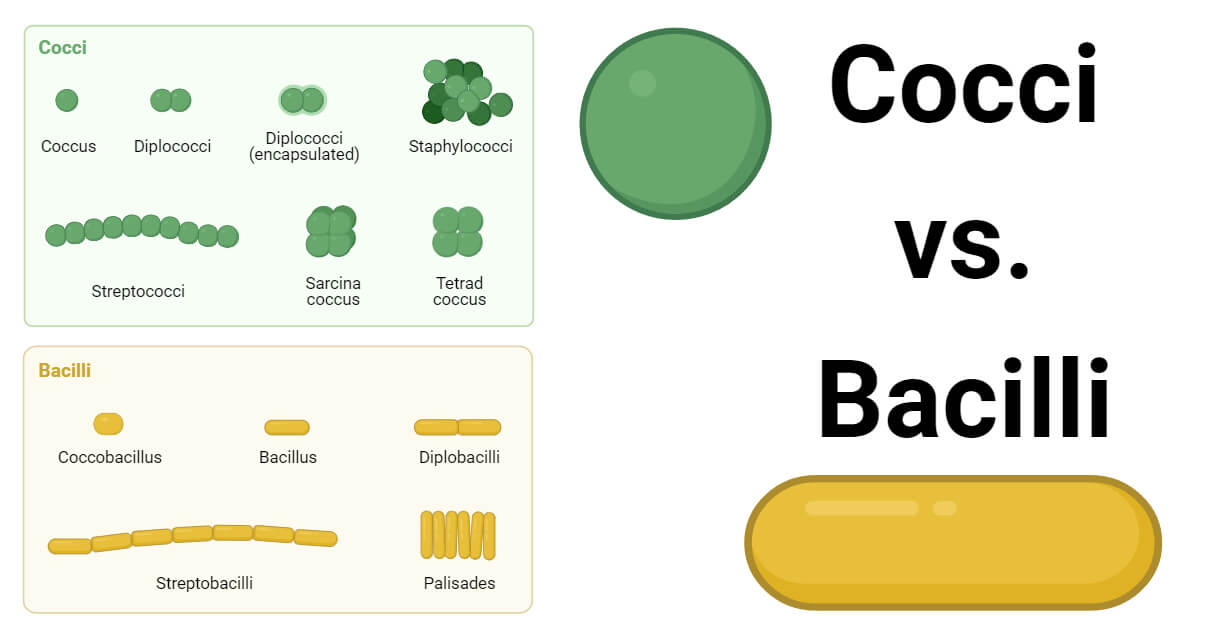Bacteria may be a domain of minuscule, microscopic, unicellular beings, but they are amazingly diverse among themselves. There are multiple classification schemes used to classify bacteria; among them classification based on their morphology is conventional and one of the simple modes of classification.

Based on their shape, bacteria are mainly classified into four main groups viz. coccus (spherical shaped), bacillus (rod-shaped), spirilla or spirochete (spiral-shaped), and vibrio (comma shaped). In this note, we will describe and differentiate coccus and bacillus.
Interesting Science Videos
Coccus (Plural Cocci)
The word ‘coccus’ is derived from the Greek word κόκκος (cóccos) meaning ‘berry‘. In microbiology, ‘Coccus’ is a term to define any bacterium or archaea that is spherical (round) (or similar, like elliptical and oval) in shape. Cocci are a group of spherical bacteria.
There are different bacterial genera that are spherical in shape. Most renowned cocci belong to Staphylococcus, Streptococcus, and Micrococcus genera. Besides, there are several other genera and species included in the morphological class coccus.
Both Gram-positive and Gram-negative cocci are identified and some of them are pathogenic to humans. Peptostreptococcus spp., Staphylococcus spp., Streptococcus spp., Micrococcus spp., Gemella spp., etc. are Gram-positive cocci and Veillonella spp., Moraxella spp., Acidaminococcus spp., Neisseria spp., etc. are Gram-negative cocci. Typically they are smaller than other shaped bacteria and generally range from 0.5 to 2.0 μm in diameter.
Many of the known cocci are anaerobic (either strict or facultative) and some genera and species are involved in different infections like pneumonia, bacteremia, wound infection, cellulitis, ulcers, UTIs, etc.
During bacterial multiplication, coccus bacteria show different arrangements of cells and based on the arrangement of cells, cocci bacteria are further sub-classified as diplococci, streptococci, staphylococci, tetrads, or sarcina.
Diplococci
Diplococci is a pair of cocci i.e. arrangement of 2 cocci bacteria in a group. During cell division, the microbial cell divides in a particular plane and remains attached forming diplococci. For example Acidaminococcus spp., Neisseria gonorrhoeae, Streptococcus pneumoniae, etc.
Streptococci
When the cocci are arranged in chain forms, they are called ‘Streptococci’. When a microbial cell repeatedly divides in a single plane and all the offspring remain attached together, streptococci are formed. For example Streptococcus pyogenes, S. agalactiae, etc.
Staphylococci
Arrangement of cocci in an irregular group forming like a bunch of grapes is called staphylococci. Repeated cell division on an orthogonal plane in three dimensions forms this arrangement of cells. For example Staphylococcus aureus, S. saprophyticus, etc.
Tetracoccus
Tetracoccus is an arrangement or group of four cocci bacteria. When a microbial cell repeatedly divides two times into two planes perpendicularly and all four offspring remain attached together, tetra coccus is formed. For example Micrococcus spp.
Sarcina
It is an arrangement of 8 or 16 cocci forming a cuboidal shape formed due to the multiplication of a bacterial cell in three dimensions. For example Sarcina spp.
Bacillus (Plural Bacilli)
The word ‘bacillus’ is derived from the Latin word ‘Bacillus’ which means ‘little staff, wand or stick’. In microbiology, bacillus is a rod-shaped (cylindrical shaped) bacterium. Bacillus is also a genus of Gram-positive rod-shaped bacteria, but bacillus simply includes all rod-shaped bacteria or archaea including the genus Bacillus and others.
Several Gram-positive and Gram-negative bacilli are known and many of them play significant in pathogenesis, ecology, and other human applications. They are typically larger than cocci and are usually 1.0 to 4.0 μm in length. Bacillus spp., Clostridium spp., Listeria spp., Corynebacterium spp., Actinomyces spp., Lactobacillus spp., Propionibacetrium spp., etc. are Gram-positive bacilli. All members of Enterobacteriaceae, Pseudomonas spp., Fusobacterium spp., Bacteroides spp., etc. are Gram-negative bacilli.
Bacillus is mostly arranged as a single isolated bacterium. During cell division, bacilli bacteria show the different arrangements of cells and based on the arrangement of cells, bacillus bacteria are further sub-classified as diplobacilli, streptobacilli, and coccobacilli.
Diplobacilli
Diplobacilli is the arrangement of two rod-shaped bacteria in a group due to the division of bacterium in a particular plane. For example Bacillus licheniformis, Moraxella bovis, Coxiella burnetii, etc.
Streptobacilli
When rod-shaped bacteria are arranged in chain forms, they are called ‘Streptobacilli’. When a microbial cell repeatedly divides in a single plane and all the offspring remain attached together, streptobacilli are formed. For example Streptobacillus spp.
Coccobacilli
Coccobacilli are rod-shaped bacteria that look like cocci due to their approximately equal length and breadth. For example Haemophilus influenzae, Acinetobacter baumannii, Brucella spp., etc.
Cocci vs. Bacilli in Table Form
| Characteristics | Cocci | Bacilli |
| Shape | Spherical, elliptical, oval | Cylindrical or Rod-shaped, curved, filamentous, spirochete, or spindle |
| Size | Variable Usually smaller than bacilli Typically 0.5 to 2.0 μm in diameter | Variable Usually larger than cocci Typically 1.0 to 4.0 μm in length |
| Arrangement | May be single, diplococci, streptococci, staphylococci, tetrads or sarcina | Mostly single or maybe in chain. |
| Spore-formation | Generally non-sporing | Some like Clostridium spp. and Bacillus spp. forms spore |
| Metabolism | Several cocci are anaerobic | Most of them are aerobic or facultatively aerobic |
References
- Sizar O, Leslie SW, Unakal CG. Gram-Positive Bacteria. [Updated 2023 May 30]. In: StatPearls [Internet]. Treasure Island (FL): StatPearls Publishing; 2023 Jan-. Available from: https://www.ncbi.nlm.nih.gov/books/NBK470553/
- https://www.researchgate.net/profile/Lakna-Panawala/publication/316617155_Home_Science_Biology_Cell_Biology_Difference_Between_Cocci_and_Bacilli_Difference_Between_Cocci_and_Bacilli/links/5907ebc4a6fdccd580dd06b6/Home-Science-Biology-Cell-Biology-Difference-Between-Cocci-and-Bacilli-Difference-Between-Cocci-and-Bacilli.pdf
- Britannica, The Editors of Encyclopaedia. “bacillus”. Encyclopedia Britannica, 7 May. 2020, https://www.britannica.com/science/bacillus-bacteria. Accessed 21 August 2023.
- https://byjus.com/biology/rod-shaped-bacteria/
- https://pediaa.com/difference-between-cocci-and-bacilli/
- https://universe84a.com/collection/streptobacillus-gram-stain/
- https://byjus.com/neet/important-notes-of-biology-for-neet-shapes-of-bacteria/
- https://microbiologyinfo.com/different-size-shape-and-arrangement-of-bacterial-cells/
- https://bio.libretexts.org/Bookshelves/Microbiology/Microbiology_(Kaiser)/Unit_1%3A_Introduction_to_Microbiology_and_Prokaryotic_Cell_Anatomy/2%3A_The_Prokaryotic_Cell_-_Bacteria/2.1%3A_Sizes_Shapes_and_Arrangements_of_Bacteria

Information is well detailed thanks